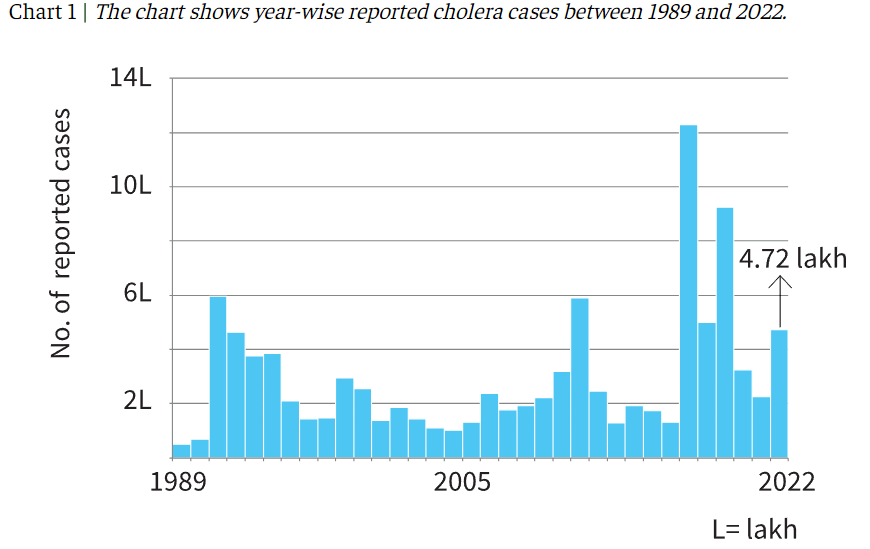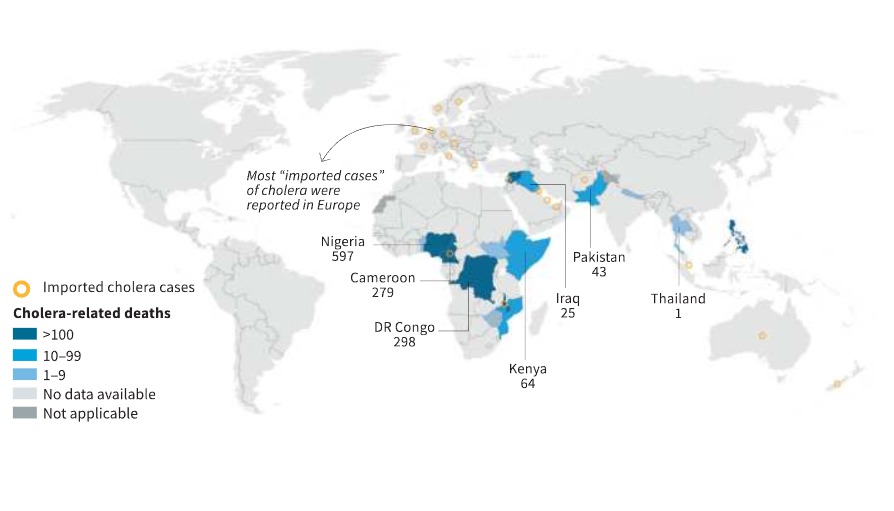Resurgence of the Cholera Pandemic | 05 Oct 2024
For Prelims: Cholera, World Health Organization (WHO), Vibrio cholerae, Oral Cholera Vaccines (OCV)
For Mains: Causes of Cholera and Related Intiatives, Issues Relating to Development and Management of Social Sector/Services Relating to Health.
Why in News?
Recently, Cholera, a preventable and treatable disease, has experienced a resurgence, leading to approximately 4,000 deaths in 2023, according to the World Health Organization (WHO).
What is Cholera?
- About:
- Cholera, a water-borne disease primarily caused by the bacteria Vibrio cholerae.
- It is an acute diarrheal illness caused by infection of the intestine.
- The infection is often mild or without symptoms, but sometimes can be severe.
- Symptoms:
- It includes severe watery diarrhoea, vomiting, leg cramps, and weakness, and can lead to death through dehydration if untreated.
- Transmission:
- A person may get cholera by drinking water or eating food contaminated with the cholera bacterium.
- The disease can spread rapidly in areas with inadequate treatment of sewage and drinking water.
- Vulnerable populations, particularly malnourished children and individuals living with Human Immunodeficiency Virus (HIV)/Acquired Immunodeficiency Syndrome (AIDS) are at a higher risk of mortality.
- Vaccine:
- Currently there are 3 WHO pre-qualified Oral Cholera Vaccines (OCV)- Dukoral, Shanchol, and Euvichol-Plus. All three vaccines require two doses for full protection.
What is the Global Distribution and Burden of Cholera?
- Global Burden:
- The global cholera burden worsened between 2022 and 2024, with the WHO reporting significant increases in both cases and deaths across various regions.
- 22 countries reported active outbreaks and 2,400 deaths had been recorded globally by August 2024.
- Global Cholera Distribution:
- Cholera primarily affects countries in Africa and Asia, with occasional "imported cases" in Europe.
- WHO reported that in 2023, global cholera cases increased by 13%, and deaths rose by 17% compared to 2022, resulting in 4,000 fatalities.
- By 2024, 22 countries were experiencing ongoing cholera outbreaks.
- In 2022, cholera cases were more evenly spread across Africa compared to 2021.
- The geographic distribution of cholera has shifted, with Asia showing a decline but cases in Africa doubling, largely due to inequities in healthcare access.
- Asia also experienced a rise in cholera cases in 2022.
- As of August 2024, India reported 3,805 cases of cholera in a multi-country outbreak that also impacted Myanmar, Bangladesh, and Nepal.
What are the Key Factors Contributing to Cholera Resurgence?
- Climate Change: It has a profound effect on water quality and availability. Extreme weather events, such as floods and intense monsoonal rains, can lead to the overflow of sewage into water sources, while droughts and heatwaves concentrate cholera bacteria in diminishing water supplies. These changes significantly exacerbate the spread of cholera.
- Lack of Access to Clean Water and Sanitation: According to United Nations Children's Fund (UNICEF), in the year 2019, approximately 2 billion people lack access to safely managed drinking water, and around 3.6 billion lack adequate sanitation facilities.
- This leads to cholera outbreaks, as contaminated water and poor sanitation create fertile conditions for the disease to thrive.
- Vibrio Pathogens and Microplastics: Research from the University of Florida in June 2023 reveals that Vibrio pathogens can adhere to microplastics, allowing them to potentially adapt to this environment in the open ocean.
- Conflict and Displacement: Regions affected by conflict face major disruptions in health services and sanitation, increasing vulnerability to cholera.
- Displaced individuals are especially at risk due to overcrowded living conditions and inadequate access to clean water.
- Vaccine Shortage and Inadequate Health Infrastructure: In 2023, only 36 million cholera vaccine doses were produced, half the demand from 14 countries. Due to the shortage, a single-dose regimen replaced the standard two doses.
- Currently, there is only one manufacturer supplying OCVs worldwide and a shortage of around 40 million doses annually.
- Also, the limited health infrastructure in affected areas exacerbates the crisis, hindering effective response and control measures.
Initiatives to Control Cholera
- Global Task Force for Cholera Control (GTFCC): GTFCC was launched by the WHO, and has created a Global Roadmap for Ending Cholera by 2030.
- This roadmap emphasises crucial initiatives such as monitoring disease transmission, engaging communities in hygiene and sanitation education, improving access to sanitation facilities in high-risk areas, and implementing OCV campaigns in cholera hotspots.
- Collaborative Efforts with Health Partners: In May 2023, seven countries and ten health partners, including International Federation of Red Cross and Red Crescent Societies (IFRC) and UNICEF, convened during the World Health Assembly (WHA) to reaffirm their commitment to combating cholera.
- They called for immediate action and sustainable funding to enhance Water, Sanitation, and Hygiene (WASH) services, strengthen disease surveillance in high-risk areas, and boost local production of oral cholera vaccines.
Way Forward
- Increased Investment: Governments and international organisations must prioritise funding for WASH initiatives to address the root causes of cholera outbreaks.
- For Example, Swachh Bharat Mission (SBM) has been instrumental in improving sanitation infrastructure and reducing open defecation, contributing to cholera prevention
- Strengthening Health Systems: Enhancing health infrastructure, particularly in vulnerable regions, is essential for effective disease monitoring and response.
- The WHOs efforts in cholera-endemic countries like Haiti and Yemen have been crucial in containing outbreaks by improving healthcare infrastructure and response capabilities.
- Community Engagement: Local communities must be engaged in hygiene education and sanitation efforts to foster ownership and sustainable practices.
- Addressing Climate Change: Governments should recognise the impact of climate change on health and implement measures to mitigate its effects.
- For Example, India took several measures such as National Action Plan on Climate Change (NAPCC), National Solar Mission, Renewable Energy Initiatives etc.
|
Drishti Mains Question Water-borne diseases continue to pose significant public health challenges in India. Analyze the factors contributing to their prevalence and suggest effective measures to mitigate their impact. |
UPSC Civil Services Examination, Previous Year Question (PYQ)
Prelims:
Q. ‘Mission Indradhanush’ launched by the Government of India pertains to (2016)
(a) immunization of children and pregnant women
(b) construction of smart cities across the country
(c) India’s own search for the Earth-like planets in outer space
(d) New Educational Policy
Ans: (a)
Q. Which of the following are the objectives of ‘National Nutrition Mission’? (2017)
- To create awareness relating to malnutrition among pregnant women and lactating mothers.
- To reduce the incidence of anaemia among young children, adolescent girls and women.
- To promote the consumption of millets, coarse cereals and unpolished rice.
- To promote the consumption of poultry eggs.
Select the correct answer using the code given below:
(a) 1 and 2 only
(b) 1, 2 and 3 only
(c) 1, 2 and 4 only
(d) 3 and 4 only
Ans: (a)


